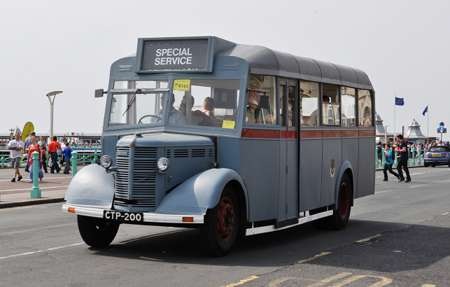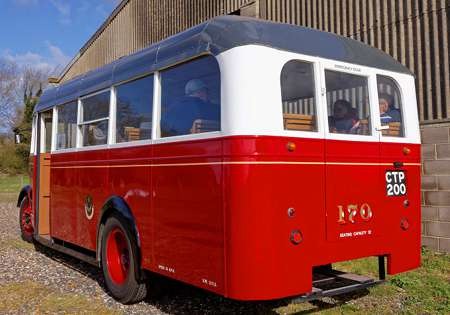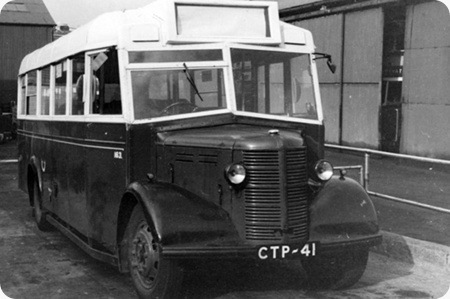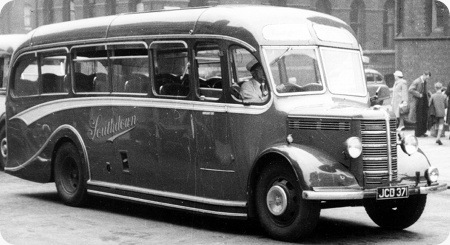
Photograph by ‘unknown’ if you took this photo please go to the copyright page.
Southdown Motor Services
1948
Bedford OB
Duple C27F
Another example of the ubiquitous Bedford OB/Duple coach, but bought by an operator who eschewed non-standard, other than for specific purposes. For this purpose, a Leyland/Harrington vehicle would not do!
Hayling Island, to the East of Portsea Island (Portsmouth) led a very quiet existence until the mid ‘30’s, when the first stirrings emerged and it became popular as a seaside resort, with a holiday camp. However, it suffered from a weak road bridge (and rail bridge, too, but that’s another story!) and Southdown purchased two Dennis half-cab Falcons in 1939, running to and from the island from Havant on the mainland.
However, although they were light enough to traverse the bridge, they were only allowed to do so if the vehicle was empty, thus, all passengers had to alight and proceed across the bridge on foot, re-joining the bus the other side!
They performed this task alone, until the two Bedfords were bought in 1948 with standard 27-seat Duple coach bodies and numbered 70 and 71 (JCD 370 and 371). Like the Dennis Falcons, they were acquired for the Hayling Island services because they were lightweight vehicles. However, being coaches, unlike the Falcons, their duties also included regular runs to London.
All four vehicles were withdrawn when a replacement bridge to the Island was built in the mid 1950s. Both Falcons were withdrawn entirely, but one survives (see HERE)
The Bedford/Duples were then transferred to other duties away from the area (No.70 was used for a while on bus services out of East Grinstead) with both being disposed of by 1960.
"Note that the coach is absolutely impeccable – a trademark of Southdown, who, for a large company, took a pride in their vehicles. Their name was always in ‘real writing’ on their coaches (and open-top austerity Guy Arab II’s) but printed on their buses. The letters were always filled with gold leaf – no expense spared!
Also, note the driver in full Summer regalia, linen jacket, with cap! Those were the days."
Photograph and Copy contributed by Chris Hebbron (with vehicle history assistance from Dick Gilbert – Classic Buses Website).
This photograph evokes fond memories of Southdown coaches regularly seen visiting Harrogate in the late sixties and early seventies. Their usual haunt was The Old Swan Hotel, an attractive and genteel establishment famous for being the one time hideaway of Agatha Christie, and very Southdown. The vehicles were usually Leyland Leopards with either Plaxton or Harrington coachwork, and Southdown used the hotel for overnight stays or as a base for excursions into the Yorkshire Dales and beyond, I seem to think. As with the Bedford Chris, the Leopards were always immaculately turned out. A coach in that rich green livery with gold script fleetname was simply a joy to behold and definitely a case of ‘less is more’ in terms of quality.
Hayling Island is also familiar, as in 1973 two West Yorkshire colleagues and I decided to spend a week at Warner’s Sunshine Holiday Centre – presumably that very same holiday camp mentioned in the text. We booked it as a bit of fun for the week, but also used it as a base to tour the area. I was therefore privileged to see many Southdown buses still in their original green and rich cream livery, with relatively few in the new NBC corporate leaf green and white. Again all were smartly presented. I can also vividly recall seeing the Tilling green buses of neighbouring Hants & Dorset running alongside some similar buses repainted in the new livery of NBC poppy RED – including an early LD Lodekka in Gosport still with its long radiator grille!
On the subject of fleetnames, like Southdown, United was another operator to use gold script on its coaches and block capitals on its buses, if memory serves correctly. In either operator’s case, the liveries were certainly much classier than some of the vinyl-clad ‘circus wagon’ offerings we have seen since from some quarters.
Brendan Smith
The first dedicated vehicles bought by Southdown for the Hayling Island services were 6 TSM B39’s with lightweight Short bodies in 1933. These were followed by 6 Leyland Cub SKPZ2’s with Park Royal B26R bodies in 1936, and 11 Leyland Cheetah LZ3&4 Coaches in 1938/39. The TSMs were commandeered by the War Office 1940. After the war 10 Dennis Falcon P4’s with Dennis 30 seat bus bodies arrived in 1949, and the 2 Bedfords augmented the Cheetahs on the Express Service to London and local excursions.
The 2 prewar Falcons were purchased in 1939 for the Tramocar service on Worthing Sea Front, and moved to Hayling Island in 1950. In addition there was an open top service using Leyland TD1’s along the sea front in summer. Also there was the train from Havant using Stroudley A1x tank engines.
In the late 40s and early 50s it was a wonderful place for a young transport enthusiast.
Pat Jennings
22/01/12 – 06:58
Not quite in the same vein, but when I was a child many many years ago I used to sit in a coach belonging to "Unique Coaches" on Brighton seafront waiting for the "Unique" day trip to commence, while numerous Southdown buses rolled past around the giant roundabout outside the Palace Pier, They had class and style, I remember them well. As a matter of interest does anyone else remember Unique Coaches.
Tony
22/01/12 – 09:16
Hi, Tony. Maybe I’m dyslexic, (or more probably just going senile and getting mixed up), but although I don’t remember ‘Unique’ coaches on Brighton seafront, I have a recollection of ‘Ubique’ coaches. Could we be thinking of the same operator? As for the Southdown buses rolling around the Palace Pier roundabout, there was a wee scam on some local services that Inspectors on regulating duties at Pool Valley needed to look out for. A few crews, (not many), due to be relieved would occasionally try to make an extra, unscheduled trip around Old Steine, thus arriving ‘late’ and so getting covered for the first trip of the later part of their shift.
Roy Burke
22/01/12 – 17:27
What a treat to see this lovely picture. My opinion of the beautiful little Bedford OB/Duple coaches was that they were classically handsome, had a welcoming and "friendly" expression, and could claim a very creditable, honest, and comfortable performance rarely matched by any other vehicle of similar general specification. What I’d give these days to hear that wonderful pure third gear wail diminishing magically into "trolleybus standard" quietness upon engaging top.
Chris Youhill
23/01/12 – 07:29
Try this YouTube clip for size, Chris Y. Start from 3mins, or shut your eyes from the beginning to that point, or you’ll get a headache! It’s ears that matter here! //www.youtube.com/
Chris Hebbron
23/01/12 – 10:13
Thank you Chris for that – my word what wonderful condition for a "utility" – someone has put some professional work into keeping that little gem in such superb condition throughout. I particularly like the "service bus" white bell push midway along the nearside. I shall now enjoy my breakfast garnished with just the mildest whiff of lovely petrol vapour – if I’d known of this bus in 2007 I might have been tempted to travel to Wales for a ride !!
Chris Youhill
24/01/12 – 05:44
Please allow me to thank you too Chris for the YouTube OWB!!
I love to listen to good music, especially a good New Orleans Jazz Band, but this has to be the Number 1 of the Top Twenty Hit Parade of all time!.
What a superbly evocative sound! It brings it all back, and the last 60 years just slip away!
I’m back in Bridlington in 1948, aboard a White Bus Service OWB.
Absolutely wonderful. Any ideas about re-experiencing other such music, say a 5LW in a Bristol "J", or anything else of equal concert variety?
Thanks again
John Whitaker
24/01/12 – 08:17
Daimler CVD6 with fluid flywheel waiting at a stop….? Anywhere?
Joe
24/01/12 – 08:17
I’m with you there in Queen Street waiting to depart for Flamborough John – Bridlington was my second home from infancy to mid thirties, and White Bus, Williamsons and EYMS were fascinating beyond description. Did you notice the incredible coincidence in the numbers of the two White Bus OWBs ?? – ASD 149 and EWW 149 !!
Chris Youhill
24/01/12 – 09:26
Thank you Chris H for such a super link which I have listened to with rapture. The Bedford OWB "music" is one you never forget. Many of my postings include a reference to sound so I wonder whether Peter might consider a new section on this site?
Richard Fieldhouse
24/01/12 – 09:27
We have a common heritage Chris! I just loved WBS, but honestly had not noticed the reg. coincidence. Lighthouse, north Landing, Thornwick Bay. What wonderful destination names they had.
I can still see a Halifax Regent at the Lighthouse turn, where some friends from Bradford had a PLSC holiday bungalow, just under the old tower!
Our bungalow was a Bradford tram, on the other side of Brid, at Skipsea, where my love of EYMS originated, with childhood memories of oval rear windows, and 3 window upper deck fronts!
Them wer`t days!
John Whitaker
24/01/12 – 10:37
John…I’ve just loaded my film of Bristol L KLJ 749 ex Hants & Dorset 779 which you might like. I’m sorry the passengers are nattering away with excitement but the bus is still doing a fine job on the way out along the A37 from Whitchurch near Bristol towards Pensford. You can view it at this link.//www.youtube.com/
Richard Leaman
24/01/12 – 10:38
…..but the musical sounds of these veteran and vintage gearboxes is a big part of what it is about for us oldies. They give character to the vehicles which is singularly lacking in the hoards of modern, soul-less sewing machines – no matter how good they may be in a definitive sense. AEC Regents (I – V), Guy Arabs and petrol Bedfords step up to plate (in particular) for post war honours.
David Oldfield
24/01/12 – 15:42
Here is the second video that you may wish to watch and listen to.
This is Bristol L C2736 on Bristol Bus Running Day with some superb gear changing! //www.youtube.com/
Richard Leaman
25/01/12 – 05:08
There was a small independent in Derbyshire who ran two services from his home village, Crich (home of the National Tramway Museum) to Derby, shopping service on Fridays and to Ripley on Saturdays. The rest of the week he was a coal merchant! His fleet was just two Bedford OB’s both bought new and I spent many happy hours as a youth travelling on them. One thing I’ve often wondered is, given that some operators re-bodied OWB’s in the late 40’s with Duple Vista bodies, what exactly was the difference between the two chassis?
Chris Barker
25/01/12 – 06:45
I stand to be corrected but I don’t think there was much, if any, difference. W was the "war" designation – just as the difference between Daimler’s COG/CWG/CVG. There may have been the use of war-time materials – Guy Arabs were heavier as a result.
David Oldfield
25/01/12 – 13:12
Hi Richard, and thanks for the wonderful "Bristolian" sound tracks. A whole new sphere of interest could open up here!
Regarding wartime Bedfords, and other makes for that matter, many alloys, and aluminium were unavailable, and had to be replaced by ferrous metals. or other materials with better availability. This tended to increase overall weight, but otherwise, I am led to believe that, design wise, there was very little difference between, say COG5 and CWG5 Daimlers, and OB and OWB Bedfords.
John Whitaker
26/01/12 – 05:50
On the subject of gearbox music, I must put in a word for the Crossley. Whatever else may have been wrong with them, there was never a sweeter transmission sound than that.
Peter Williamson
I am at the moment working on a new page for the site titled ‘Old Bus Sounds’ which will be a bus sound reference library. Should go live this weekend hopefully.
Peter
26/01/12 – 10:48
I don’t recall any noticeable transmission delights with Portsmouth’s DD42’s, but they had Brockhouse Turbo Converters, presumably with different transmission.
However, when most of them were converted to house Leyland TD engines, the TD gearboxes were fitted with the engines. That gave them a new sound dimension as well as fooling some folk!
Their sole 1931 Crossley (later converted into a breakdown tender, now preserved) has a wealth of interesting noises – //www.youtube.com/
Chris Hebbron
27/01/12 – 06:16
Aluminium was in short supply in the automotive field during World War II, as John points out, due to its increased use in helping the war effort, and as a result many vehicle components had to be made of other materials. Gardner, for example used cast iron for its LW crankcases, endplates, sumps, water pump and fuel injection pump bodies etc, for the duration. From their point of view, as they already offered this option on their marine range of engines this would not have been too much of a problem – provided they could get the cast iron! From an operating point of view the extra weight must have had a somewhat detrimental effect on fuel economy and performance though. For a few years in the 1980’s a cast iron 5LW languished in the bike shed at West Yorkshire Road Car’s Central Repair Works. Where it came from and where it went to remain two of life’s little mysteries unfortunately. (I was informed by a knowledgeable United CRW fitter some years ago that the cast iron wartime Gardners had one piece cylinder blocks fitted instead of the usual pairs).
Thanks to Chris and Richard for passing on the delightful Bedford and Bristol sound effects and film clips. Wonderful stuff. Just as Chris Y was transported back to ‘Brid’ with the Bedford, I was instantly transported back to the 1960’s, riding on a West Yorkshire Bristol L on service 58 between Bradford and Shipley – only this time I didn’t need to pay! I wish you well with the ‘Old Bus Sounds’ Peter. It should prove very popular, and what a brilliant idea. Can’t wait for the first ‘instalment’!
Brendan Smith
27/01/12 – 06:33
Many thanks, Chris H, for the wonderful Condor link: I’d never seen or heard that running before but the video is as good as being there on the spot. Thanks too to Richard L for the Bristol L link: I’m afraid the bloke with the cap and rucksack, blocking the forward view, is me!
The idea of an Old Bus Sounds page is brilliant. Long live the straight-cut geartooth!
Ian Thompson
27/01/12 – 08:40
Gentlemen, thank you for the very kind comments and Ian, you were enhancing the view, not blocking it! In case anyone was wondering, the route on C2736 was from Bristol Temple Meads along the A4 Bath Road, past the former Colthurst and Harding paint works, Arnos Vale Cemetery gates, the imposing stone building with the tall archway is Brislington Tram Depot (still in fine order and use by Bristol Council, then up the hill to finish just as we arrive at the remains of the entrance to the Bristol Commercial Vehicles Ltd.
I thought that it may be of interest to show the two buses in the clips and also a set of Bedford OB/OWB pictures which I took at the Kemble Steam Fair in August 2008. For those of us delighted by the OB gearbox, on that occasion, it was possible to hear eighteen of them all at once as they did a "convoy" lap! They can be seen at this link.
Richard Leaman
27/01/12 – 08:42
Your comment, Brendan, brought back some very evocative memories of East Parade. Jack Lawrence was a most impressive person. I can’t claim to have known a great many Traffic Managers, but of the ones I ever met, he was in a class apart. He was authoritative and clearly had his fingers firmly, (and intelligently), on the pulse of every aspect of the company’s operations. Gordon Dingle – a lovely man, and I was sad to learn that he has passed on – was at that time in charge of the Charting Department which controlled the loadings for the whole Yorkshire Pool and also the hiring of dozens of independent coaches for WY’s summer Saturday coastal stage carriage operations. Efficient, effective and profitable.
Maidstone & District, (and I repeat my great regard for that company), applied a diametrically opposed policy on their London express services, although in practice they were very similar. Sadly, that policy was dreadfully inefficient in its use of vehicles and was expensive in wages. It was actually difficult even to work out the true operating cost of any of those important services, a situation I couldn’t conceive at WY.
It would be diplomatic to avoid another reference to Southdown here, Brendan. I’m glad you still have a soft spot for them.
Roy Burke
27/01/12 – 14:24
Here are some more Bedford OB sounds – Wonderful ! //www.youtube.com
John Stringer
28/01/12 – 09:08
That’s a brilliant clip, John. I’m just old enough to recall the petrol-engine’d London Transport LT’s with open staircases, which sounded much like these vehicles.
Grossly overloaded in the late-forties, they would pull away with juddery clutch biting and more than the shaky wow-wow sound at low revs. I also drove a petrol-engine’d Austin K6 across Scotland once, which was full of character, but the gearbox was quieter than the Bedford’s, though far from quiet! All that double de-clutching was fun!
Chris Hebbron
28/01/12 – 11:07
I had no idea that wartime Gardner engines were themselves subject to wartime material alteration , so thanks Brendan, for that interesting fact.
Its good to hear also that my external feel for the efficiency of WYRC is borne out in fact by those "in the know"!
I am with you Brendan on that L5g between Bradford and Shipley.
John Whitaker
28/01/12 – 16:23
Hello Roy you are quite right about the name Unique Coaches of Brighton and their stand on Marine Drive, they were painted in a very attractive dark green livery. If my aged memory is right I think their garage was close to Brighton station just down the hill leading down to Old Steine it may have been Trafalgar Street but I am far from certain of that. My recollections date back to the late 50’s early 60’s the fleet at that time included at least one Harrington bodied Bedford SB.
Diesel Dave
10/07/12 – 18:31
Found a shot of Unique Harrington bodied SB3 1800CD on Flickr. Just Google Unique Coaches Brighton and click on Images. Southdown had 2 batches of Commers with similar Harrington bodies (Not one of their better efforts!)
Their depot was in Trafalgar St., and the livery was two shades of green. I believe they later sold out to another local operator ‘Campings’
Roy Nicholson
14/09/12 – 07:28
Just read some of the stories above, Southdown always had a good looking fleet with good maintenance. As a 15/16 year old I worked at the Royal Parade depot in Eastbourne until I came to Australia. I remember Arthur Martin and all the other guys saying then that Southdown had some of the best buses/coaches in the country, nice to see it, 50 years in writing
Deryn Cox
06/12/14 – 06:44
What is the unladen weight of 1948 Bedford OB Coach?? Can it be driven on UK Licence, A, B1, B, BE, as it is Vintage and not used for passenger carrying, just for Showing???
Bradley Borland
06/12/14 – 12:41
The unladen weight of a Bedford OB/Duple Vista coach was 3tons 14cwt.
Chris Hebbron
 Vehicle reminder shot for this posting
Vehicle reminder shot for this posting
07/04/15 – 07:00
Not a technical question much as I enjoyed reading through all the information and comments about the Southdown Bus Company.
I am now aged 78. As a schoolboy in the late forties/early fifties I lived at Felpham, near Bognor Regis. The Southdown buses that then passed through Felpham were the 31, 50, 50A and 69.
As a boy I remember being told that the 31 then running from Brighton to Portsmouth was the longest bus journey in England that would stop at every Request Stop (if required) during the length of its journey.
I should be pleased to hear if any one can confirm that this was indeed correct.
Ross Sarel
08/04/15 – 06:20
I’d say, Ross, that the 31 from South Parade Pier, Southsea, to Brighton (Marine Parade?) via Worthing would be about 66 miles, but stand corrected. Although not in England, in the late 1950’s, during my National Service, Western SMT had a normal double-deck route which ran from Stranraer to Glasgow, via Ayr Depot, for re-fuelling and toilet break. It was about 85 miles long and took four hours. The longest normal bus route I know of was Midland Red’s X91 service, running twice a day between Leicester and Hereford along the following route: Leicester – Hinckley – Nuneaton – Coventry – Kenilworth – Leamington Spa – Warwick – Stratford-on-Avon – Evesham – Pershore – Worcester – Great Malvern – Malvern Wells – Ledbury – Hereford. It was something over 100 miles long and took 4.5 hours. The ‘X’ prefix really meant long-distance rather than express. We are talking of the 1950’s again. It used normal single-deck buses because of low-bridge problems and was busy enough to warrant duplicate vehicles at popular times.
Chris Hebbron
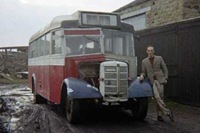 Vehicle reminder shot for this posting
Vehicle reminder shot for this posting
